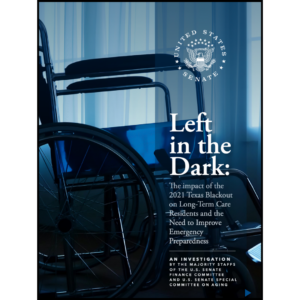Form follows financing
I know this is a radical thought, but it just seems to me that healthcare financing and reimbursement systems ought to focus on the needs of the customer. They should be a function of customer need—perhaps even of customer preference. But they aren’t, and the customer suffers as a result (perhaps without even realizing it). This is true of both Medicare and Medicaid—unfortunate for us, in that these are the primary funding sources for long-term care.
Certainly, both programs have brought significant benefits to seniors. By virtually any measure, the introduction of Medicare led to a dramatic increase in seniors’ overall quality of life. The number of elderly people living in poverty dropped from 28% in 1960 to less than 9% today; a significant reason for this may be that Medicare has enabled many people to avoid depleting their assets to fund medical care. And Medicare continues to provide seniors a level of medical security previously unknown in the United States.
That notwithstanding, Medicare is structured as if recipients need only short-term care when, in reality, aging is best characterized by chronic conditions. But Medicare is not designed to pay for such conditions (much less for long-term care). Because of these and other constraints, Medicare in 2000 paid beneficiaries only about half of their total personal healthcare expenditures.
Because Medicare covers barely half of all seniors’ medical costs, lower-income elderly in particular need additional assistance to obtain adequate healthcare. This is not an insignificant population: 43% of seniors—13 million people—have incomes below $15,980 for one senior living alone or $20,150 for two seniors in one household. Clearly, individuals in this income range could not afford long-term care without significant financial support.
For the poor, this gap has been made up for by Medicaid. Medicaid has met its intended goal of providing greater access to healthcare for low-income seniors, and beneficiaries eligible for both Medicare and Medicaid spent only 4.6% of income for healthcare.
Medicaid pays for those more prevalent conditions among seniors that Medicare does not. Although the elderly are only a small percentage of Medicaid recipients (17%), they consume the largest percentage of program dollars. That’s because the program is the largest insurer of long-term care for all Americans, including the middle class, covering 66% of nursing home residents and over 50% of all nursing home costs.
The downside of all of this (along with the personal stigma of being on “welfare”) is that Medicaid is breaking the proverbial bank. That is the issue which, if not successfully addressed, might lead us 20 to 30 years hence to refer to these as the “good old days.” Medicaid was never envisioned as the primary funding mechanism for long-term care. It assumed that role because of the concept called “spend down,” providing nursing home services to those whose healthcare costs have impoverished them. Aside from guiding Americans toward the institutional setting that most would prefer not to use, Medicaid coverage has perpetuated a notion that long-term care is free. Forget about that half of America’s seniors who, according to AARP data, falsely assume that Medicare will pay for their long-term care costs. Even those who understand the distinctions between the two programs have come to see Medicaid-funded long-term care as a “free” good (or at least, like Medicare, an entitlement paid for with their tax dollars).
Stephen Moses, president of the Center for Long-Term Care Reform, put it best in a 2005 Cato Institute monograph, “Aging America’s Achilles’ Heel”:
The fundamental problem with LTC financing is that government pays for so much of it that the public has been anesthetized to the risk and expense of high-cost extended care. People can ignore the risk, avoid the premiums for private insurance, wait to see if they will need LTC, and transfer the cost to taxpayers. Is it any wonder that so few Americans buy private insurance or use reverse mortgages to finance LTC? Is it any wonder that most Americans who need LTC end up dependent on Medicaid?
Steve’s solution is a simple one (although its political viability might be something else again). He would severely truncate many of the currently legal methods used by seniors to preserve assets while maintaining their Medicaid eligibility. He would eliminate all or most of Medicaid’s open-ended home equity exemption for long-term care recipients, while placing limits of the amounts of other assets people could shelter. And he would extend the look-back period for the transfer of real property from five to twenty years.
Such measures would lead most Americans (particularly the children of otherwise eligible seniors) to think much more seriously about private methods of long-term care financing (e.g., insurance). After all, with the house gone, there would be less or no estate to inherit. Worse, the financial burden of caring for mom or dad might rest on the child’s own shoulders—as, in fact, it does today in many cases, as baby boomers are slowly becoming aware.
Since we’re talking here about the politically problematic, I might even take Steve one step further. My concern is not just the 22% of Medicaid recipients that Steve suggests would no longer be inappropriately eligible. I am equally concerned about those who would be eligible. While one might argue that the resulting $30 billion dollars in annual savings (Steve’s estimate) would be used by federal and state governments to increase reimbursement rates and thus improve the quality of care in today’s nursing homes, I wouldn’t hold my breath.
Rather, I would get the government out of rate-setting altogether. To date, that role has been filled with an almost single-minded focus on reducing program costs, rather than meeting customer needs. And the results are obvious. What’s the alternative? Why not just provide the truly eligible recipient with a voucher, at whatever level the program is willing to pay (probably less than the cost of the service itself because long-term care can be very expensive). Allow his or her family to supplement that voucher with their own resources if they chose to purchase a level of care higher than government is willing to pay for.
When I suggested this approach a few weeks ago before the American Medical Association’s (AMA’s) Council on Medical Service, which was looking into long-term care financing, I was immediately confronted with the suggestion that I was advocating a two-tiered system of long-term care. So, what else is new? Does anyone really want to try and convince me that the $241 a day semiprivate nursing home rate in Rochester, New York is buying the same level of service as the $125 a day semiprivate in Indianapolis (data from MetLife, 2004)? That the difference is all made up by labor costs or some other uncontrollable variable(s)?
Let’s face it—equality of healthcare has always been a myth. I’ll say it again: Healthcare is a function of financing, not need. We get what we pay for (or what the state programs or insurance will pay for). So recognizing that reality and accepting it might just allow for a more viable (or at least understandable) form of program cross-subsidization. We already know (and CMS has confirmed) that Medicaid grossly underpays America’s nursing homes—to the tune of more than $4 billion dollars per year, according to the well-reputed accounting firm of BDO Seidman. Non-publicly funded residents used to have to make up the difference, but that is an increasingly heavy burden on a rapidly declining pool of private-pay residents, many of whom have long since moved off to assisted living.
As Steve eloquently argued at that same meeting of the AMA Council on Medical Service, something has to give. Inappropriate as Medicaid might be as society’s primary long-term care financing vehicle, it is experiencing fiscal pressures sufficiently serious to call its very existence into question. Jointly financed by the federal and state governments, Medicaid is the fastest-growing component of state budgets and, especially in today’s troubled economic times, there are serious questions whether the various states can continue to bear the burden. If the states can’t keep up, will long-term care be among the first programs on the chopping block?
The demographics would suggest “yes.” Over the next third of a century, the American population will grow by some 35%. That segment most in need of long-term care services, however (Americans over the age of 85), will grow by an astounding 400%!
So where does that leave us? Well, it leaves us in a political quandary. We have a financing “system” which both impoverishes those who use it and steers them in the direction of services most would prefer not to use. Worse, we have a financing system that is unlikely to withstand the fiscal pressures accompanying the upcoming “silver tsunami.” It is certainly a situation ripe for political resolution—but don’t count on that happening anytime soon.
It is puzzling how adroitly the Congress can ignore this issue (as it ignores most issues) until it’s too late. Look at the recently enacted prescription drug benefit under Medicare (Part D). CMS’s own data indicated that close to 70% of America’s seniors had at least partial insurance coverage for prescription drugs, and for those who didn’t and who needed prescription drugs, only a small percentage found the fiscal consequences catastrophic. Contrast that with long-term care. Less than five percent of seniors have insurance coverage for long-term care expenses. And of those who don’t, the vast majority will face bankruptcy if those services are ever needed. Clearly, the reasonable conclusion would have been to focus on long-term care back in 2003, not drugs.
And therein lies the dilemma. The end result was not reasonable. It was political. The solution was focused not on need, but on what will get congresspersons (and Presidents) reelected.
Perhaps, we have only ourselves to blame. It is we, the American public, who choose to deny the reality of aging. We see it all around us. In the entertainment world we choose to deny this in the way we market products and services—we deny this even in our educational systems.
As once a bureaucrat, then as a lobbyist, now as an academic, I’ve been both amazed and distressed at how little attention we pay to aging in our society. Even in my current profession, less than 10% of U.S. medical schools require even a course in geriatric care. (In England, by contrast, it is one of the largest medical specialties.) If we as a nation choose to ignore the reality of an aging population, is it any wonder that our politicians do the same?
There are no easy solutions. They are all politically and ideologically charged, involving those ranging from the advocates of public financing on the one side to those favoring exclusive private responsibility on the other. They all cost money, lots of money. So why should it surprise us if Congress takes the easy way out, especially if those of us who will cast votes in the next election seem to have little interest in pursuing the issue?
Let us not be surprised if, 30 years hence, we all reap what we have sown.
To send your comments to Dr. Willging and the editors, e-mail willging0308@iadvanceseniorcare.com.
Related Articles
Topics: Articles , Facility management , Finance











